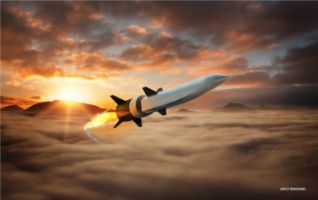Top 3 Trends Impacting the Global Hypersonic Missiles Market Through 2021: Technavio
Technavio’s latest market research report on the global hypersonic missiles market provides an analysis of the most important trends expected to impact the market outlook from 2017-2021. Technavio defines an emerging trend as a factor that has the potential to significantly impact the market and contribute to its growth or decline.
This Smart News Release features multimedia. View the full release here: http://www.businesswire.com/news/home/20170721005401/en/

Technavio has published a new report on the global hypersonic missiles market from 2017-2021. (Graphic: Business Wire)
This report is available at a USD 1,000 discount for a limited time only: View market snapshot before purchasing
Buy 1 Technavio report and get the second for 50% off. Buy 2 Technavio reports and get the third for free.
The top three emerging market trends driving the global hypersonic missiles market according to Technavio research analysts are:
- Emergence of scramjet technology
- Development of hypersonic boost-glide weapons
- Use of 3D-printing in building hypersonic missiles
Looking for more information on this market? Request a free sample report
Technavio’s sample reports are free of charge and contain multiple sections of the report including the market size and forecast, drivers, challenges, trends, and more.
Emergence of scramjet technology
Propulsion systems play a critical role in determining the range, payload, and speed of a missile. The major propulsion systems currently used in rockets and missiles are turbofans, turbojets, and ramjets. Supersonic systems, which travel at a speed of Mach 2-4, run on the ramjets technology. However, in the recent years, there is an increasing need for rockets with higher speeds. This has led to the development of a new propulsion system called scramjet, or Supersonic Combustion Ramjet.
“Many nations are using the scramjet technology for the development of hypersonic missiles, mainly because it draws the external oxygen necessary for the engine combustion and passes it through the vehicle. This eliminates the need to have an onboard tank, thereby making the missiles and aircraft smaller, lighter, and faster,” says Moutushi Saha, a lead analyst at Technavio for defense research.
Development of hypersonic boost-glide weapons
Boost-glide weapon systems are a class of spacecraft, or missile guidance systems, developed to address the demand for long range and imperceptibility. The hypersonic boost-glide weapon is a delivery vehicle that consists of a rocket and warhead. The rocket motor helps in guiding the boost-glide weapon from the upper atmosphere to outer atmosphere with the help of aerodynamic lift. Once the boost-glide weapon reaches hypersonic speed, the warhead gets detached traveling at hypersonic speed to hit the target.
The launching profile of boost-glide weapons is similar to that of the traditional ballistic missile but does not enter the Earth's orbit during its flight path. This feature of boost-glide weapons acts as tricky targets for existing, slower-moving interceptor missiles.
Use of 3D-printing in building hypersonic missiles
3D-printing is a computer controlled additive manufacturing technique in which a digital model is turned into a 3D object by adding layers and layers of thin slices of horizontal materials. The use of 3D printing is increasing rapidly because of its ability to create complex shapes and sizes of objects in minimal time and at a nominal cost. SpaceX, for example, has a large 3D printer that is being used for making parts that are currently used in the production of rocket engines.
“The construction of hypersonic systems requires exotic materials and eccentrically shaped components, which are difficult to handle with the conventional methods. For example, drilling a cooling channel manually or by automation will result in a vent that would be straight, but with the help of a 3D printer, this vent can be of elaborate shapes, like helices, which release heat much more efficiently,” says Moutushi.
Browse Related Reports:
- Global Shooting Ranges Market 2017-2021
- Global SONAR System Market 2017-2021
- Global Defense Tactical Computers Market 2017-2021
About Technavio
Technavio is a leading global technology research and advisory company. Their research and analysis focuses on emerging market trends and provides actionable insights to help businesses identify market opportunities and develop effective strategies to optimize their market positions.
With over 500 specialized analysts, Technavio’s report library consists of more than 10,000 reports and counting, covering 800 technologies, spanning across 50 countries. Their client base consists of enterprises of all sizes, including more than 100 Fortune 500 companies. This growing client base relies on Technavio’s comprehensive coverage, extensive research, and actionable market insights to identify opportunities in existing and potential markets and assess their competitive positions within changing market scenarios.
If you are interested in more information, please contact our media team at media@technavio.com.
View source version on businesswire.com: http://www.businesswire.com/news/home/20170721005401/en/






